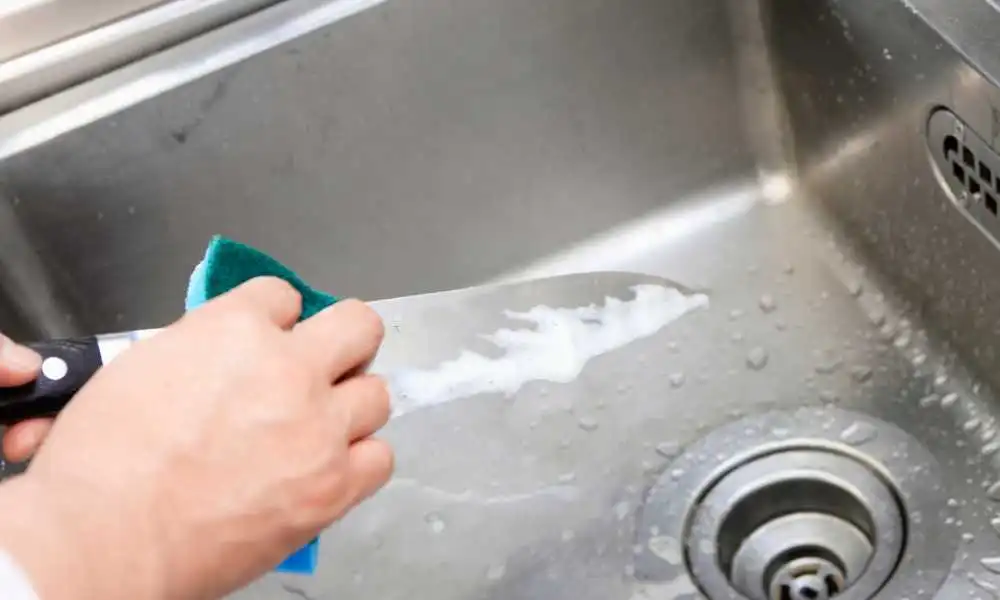When it comes to decorating a dining room, there is one key element that can make all the difference – a clean knife. Whether you prefer the classic look of stainless steel or want to add a touch of color with ceramic knives, ensuring your knives are properly cleaned will help you achieve the desired aesthetic. In this article, we’ll provide some helpful tips on how to clean your knives so they look their best and last longer.
Having a clean and inviting dining room is essential for creating a pleasant atmosphere for hosting meals. Good cleaning habits also prevent you from having to replace kitchen items more frequently than necessary. One of the most important items in the kitchen to keep clean is the knife. In this article, we will provide some helpful tips on how to properly clean a knife and keep your dining room looking great. With the right techniques, you can ensure that your knives remain spotless and rust-free for years to come.
What is the best way to clean a knife?
Cleaning knives is an important part of food preparation and kitchen safety. Without proper cleaning, knives can become dull and potentially hazardous due to the build-up of residue on the blades. Knowing how to clean a knife properly can help ensure your knives stay sharp and safe for use.
The best way to clean a knife is by hand with warm water and dish soap or a mild detergent. It’s important not to submerge your knives in water as this can damage them over time. Instead, rinse the blade under running water and then use a damp cloth or sponge with some detergent or soap to wipe away any dirt from the blade. For tough stains, you may need to scrub slightly harder but be sure not to apply too much pressure as this could damage your knife.
Cleaning Knives
Having a clean knife is essential for any kitchen. Without one, food prep can be slow and inefficient. Cleaning knives properly is easy and straightforward. Learn how to keep your knives in tip-top shape with these simple steps!
The first step in cleaning a knife is to rinse it off with hot water. Make sure to use an abrasive scrubbing pad if stuck-on food particles are present. This will help remove any dirt or grime that has built up on the blade’s surface over time. If you want extra shine, add some dish soap to the water as well.
After rinsing, dry your knife thoroughly with a soft cloth or towel before putting it away. It’s also important to store your knives safely so they don’t get damaged or dulled from contact with other utensils or items in drawers and cabinets.
Gather Necessary Tools
Knives are one of the most important and versatile kitchen tools. Cleaning a knife is not only necessary for food safety, but it also helps ensure that your trusty blade lasts longer. Gather up all the necessary tools so you can clean your knives with ease.
To get started, you’ll need a soft cloth or sponge along with dish soap and hot water. You may also want to have a blunt butter knife on hand in case there is any stuck-on residue or food particles that need to be scraped off before cleaning. Additionally, keep some baking soda and vinegar handy as these are useful ingredients for removing rust spots or tough stains from stainless steel blades. Finally, don’t forget to set aside a bowl of warm water mixed with a few drops of baby oil to lubricate your knives after cleaning them.
Wash the Knife
Cleaning a knife is an essential task for keeping your kitchen clean and safe. It’s important to wash your knives after each use, as this will prevent the spread of bacteria and dirt. Doing so regularly also helps to keep the blade sharp and protect it from rusting or tarnishing. Here are some tips on how to properly wash a knife:
First, prepare a sink filled with warm water and detergent. Submerge the blade in the water and then use a soft-bristled brush or cloth to scrub away any food residue or grease that may have built up on it. This should take no more than two minutes; then rinse off the detergent with cold running water. Be sure to dry the knife thoroughly with a microfiber cloth before storing it away safely in its sheath or block.
Dry and Polish the Knife
Cleaning your knives is an important responsibility for any home chef. A clean, sharp knife is key to not only creating a great meal but also keeping yourself safe from kitchen accidents. If you want to make sure that your knives are as good as new, it’s important to properly dry and polish them after every use.
The first step in cleaning a knife is drying the blade with a soft cloth or sponge. Make sure to start at the handle and move toward the point of the blade, wiping away any particles of food or water still clinging to it. Once you’re sure that there’s no moisture on the blade, you can begin polishing it with steel wool or another metal cleaner of your choice. This will help bring out its natural shine and keep it looking great for years to come.
Disinfect the Knife
When it comes to kitchen cleanliness, a sharp knife is essential. Not only does it make food preparation easier and quicker, but it helps keep you safe while in the kitchen. But how do you ensure your knife stays properly disinfected?
The best way to keep your knives free of bacteria and germs is to regularly clean them with hot water and dish soap. Be sure to scrub all surfaces of the blade as well as the handle for a thorough cleaning. After washing, rinse off any remaining soap residue with hot water and dry thoroughly with a paper towel or cloth towel. Once cleaned, use an antibacterial spray or wipe down the entire surface area of the knife including both sides of the blade as well as the handle. This will help disinfect your knife and reduce the risk of spreading germs when handling produce or other items in your kitchen.
Storage Considerations
The first step to properly cleaning a knife is assessing the type of knife you are dealing with. A kitchen knife may need a different treatment than a pocketknife, so it’s important to take into consideration the material and design of your blade before going any further.
Once you have identified the type of knife, you should wash it with warm water and soap. If necessary, use a brush or toothpick to get rid of any food particles that may be stuck in crevices. Additionally, make sure to dry off your knife thoroughly once washing is complete; leaving your blade damp can result in rusting or discoloration over time.
In terms of storage considerations for your clean blade, ensure that there is no contact between other objects (such as other knives) when being stored away in a drawer or kitchen countertop container.
Conclusion:
Cleaning your knives properly and regularly will help ensure that they last longer. This is especially important if you use your knives frequently in the kitchen. With just a few simple steps, you can make sure that your knives are always clean and sharp. Remember to always be careful when cleaning knives as they can be very dangerous if not handled correctly. Finally, take the time to store them safely away from other utensils and food items – this will help keep them in optimal condition for years to come!






